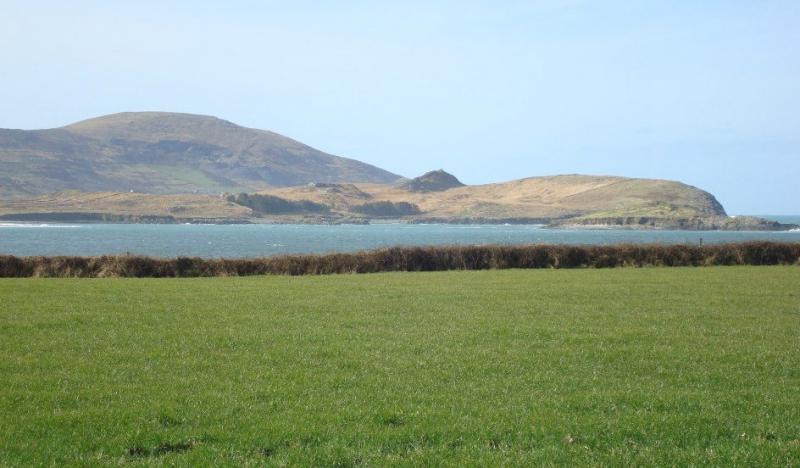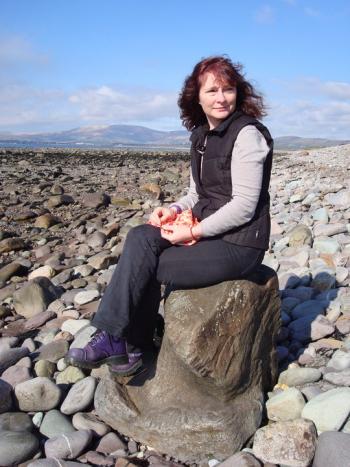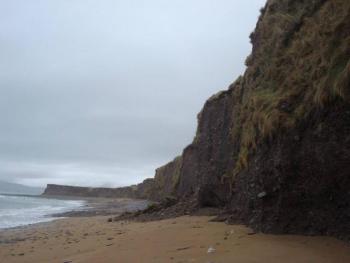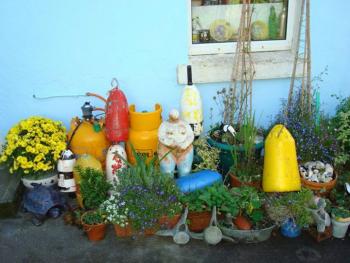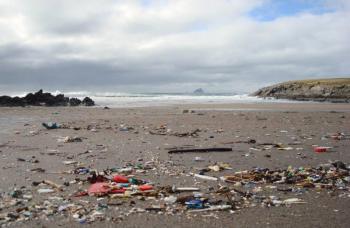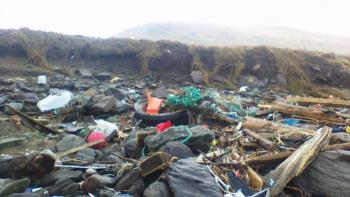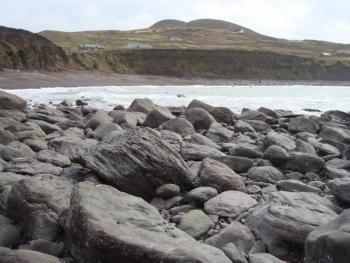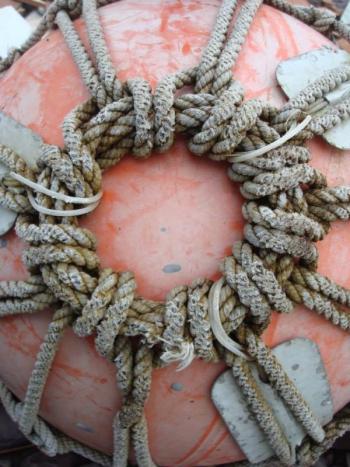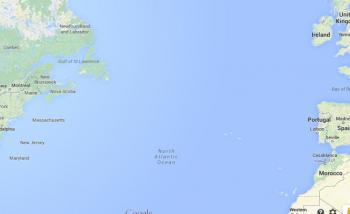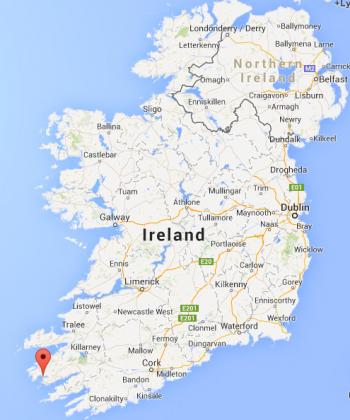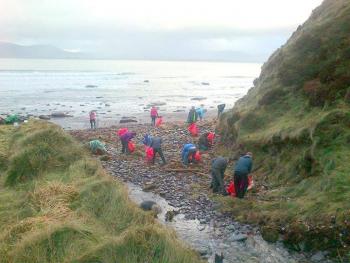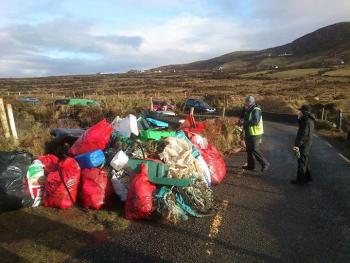Maine’s treasures (and trash) wash up on Ireland’s beaches
WATERVILLE, Ireland — Rosemary Hill combs the beaches of County Kerry, Ireland, discovering sea glass, pottery, driftwood and bleached bones. She also picks up lots of plastic and foam — broken toy soldiers and animals, snowmobile runners, furry slippers and fishing line. And, she finds many lobster buoys that once floated in the waters off of Friendship and Owls Head, or Cape Ann, Mass., or Newfoundland and Nova Scotia.
“You never know what you are going to find,” she said, in a telephone conversation between Camden and her home in Waterville, Ireland, on a cold February afternoon. “I have come across coconuts that have drifted in. There is this sense of wonder and you just don’t know what you will find next.”
Hill’s home lies at latitude 51.8276° N, eight degrees above the latitude of Friendship, at 43.9836° N. Although 2,713 miles apart, they are two like-minded communities focused on fishing, gardening and making a go of it on the North Atlantic. It is the weave and undulations of sea currents that bring them closer together.
“It’s a fishing community here,” she said, describing her town. “And like there, everyone knows everybody.”
‘I'm a lobsterman from Maine (or was) and a lot of that stuff falls into the drink by way of storms and wind. It's hard to keep yourself from falling over and floating to Ireland sometimes, let alone a couple plastic bands and some buoys. Thanks for cleaning up though; I used to love beach-coming.’
— a comment on Beachcoming in Kerry
Hill is connecting her world to Maine, and communities around the sea, by virtue of her Facebook page, Beachcombing in Kerry, which she created in September 2013 and where she uploads photos and commentary of her latest beach discoveries. New friends pop in daily.
One day while out walking, she came across a royal blue lobster buoy with the words “Mr. Koffee” etched on it.
“Its color caught my eye, lying against the grey rocks,” she said.
Intrigued, and with a growing collection of lobster trap tags and buoys from the North American shores, she decided to dig into their stories.
“These things have traveled so far,” she said. “Somebody put that on his pot on the other side of the world.”
The buoys and gear are marked by numbers, and some with names. She has a tag belonging to Figgy Duff, of Cape Breton, and buoys from the Miss Beth of Bass Harbor and Amanda Laykin of Cape Porpoise.
There are other finds: Bags of “Seven Oceans” emergency drinking water (a lot of these have been coming in lately, she remarked on her Facebook album), a large buoy from a French fishing vessel, pieces of distress signal devices, doll heads and intricately knotted lines that some talented seamen wove. And then there are the shoes — sandals and boots, even a little girl’s ballerina shoe.
She has lobster tags from up and down the coast of Maine, and now that her Facebook page has caught on, mariners who live and work along the Atlantic rim are recognizing their own personal artifacts that have, in one way or another, made it into the hands of this Irish woman. They comment on her page; some have sent her photos of their boats, which she posts, visually linking the sea-washed pieces with their owners and vessels, and completing a story.
One lobsterman commented on her page: “I'm a lobsterman from Maine (or was) and a lot of that stuff falls into the drink by way of storms and wind. It's hard to keep yourself from falling over and floating to Ireland sometimes, let alone a couple plastic bands and some buoys. Thanks for cleaning up though; I used to love beach-coming.”
But it was that royal blue buoy that especially resonated with her, so Hill put on her detective hat. It had washed up a few years prior, and Hill had placed it near her garden’s edge, on the patio with a collection of other favored mysteries.
With her connections growing, she contacted the Maine Lobsterman’s Association, and then, “in a flash of inspiration, I thought I’d try to find a Facebook page/group for the boatmen themselves, and stumbled upon the Maine Lobster Boats group.”
"I shared my album of photos of the tags and buoys on their page and it really took off," she said. "We've been able to trace back several finds to fishermen in Maine."
Then, a private message arrived from the widow of Owls Head fisherman Joseph Fournier, who owned the boat, Mr. Koffee, before he died in 2004. Barbara Fournier lives in Owls Head, and she wondered if Hill might send the buoy home to her. Her husband's boat had been sold, its buoys, too.
Hill brought the buoy inside and set it beside the stove to dry out, before boxing it up and posting it to Barbara.
"I was honored to be able to do this for her," she said.
Barbara reported receiving the buoy. It had come home more than 10 years after it was cut loose from the gear and carried eastward over the sea to Ireland.
The dark side of plastic
But it is not all beauty on the Irish beaches. With the treasures come the piles of trash polluting the waves and collecting on the beaches. It is a symptom of the age of plastic, and made especially problematic with the wild storms of these past few years.
Hill became acutely aware of this when she moved back home from Birmingham, more than 10 years ago.
She had grown up in Waterville (the town lies between a lake and the ocean), and spent her childhood exploring the rocky shore and sandy beaches. She studied microbiology in County Cork and zoology in the UK before taking what she calls, “a leap of faith” and returning, with her husband, to the small seaside village. They found jobs, and just like most residents of Maine, work hard to live in a beautiful, though poor, part of the world.
The plastic on the beaches bothered her, and she documented the growth of it all.
“I had taken so many photos of the rubbish,” she said.
It washes up from all over — from Spain, New England, Canada, carried on currents that circle the North Atlantic, and arrives in great ocean swells churned by massive storms.
“This winter we have had awful storms,” she said. “Some mild spring days and then more storms. We were without power and Internet for five days.”
An Australian university website presents a moving bloom of the path that plastic trash takes on the oceans of the globe. The ubiquitous presence of plastic in 21st-Century life is filling the waters, and because it is light, it floats. There are areas in the Pacific and Atlantic where it collects as huge floating islands.
Tides push trash and plastics out of the Gulf of Maine, where it gets caught up in the North Atlantic current that runs over to County Kerry. If it doesn’t wash ashore there, it might move down toward Spain, and then ride the Southern Atlantic current back over to the Caribbean.
The ferocious storms have inundated the shoreline in County Kerry with tons of trash. Residents there went out with black garbage bags to move it off the beaches and rocks. Even a car washed up on Ballyheigue Beach this winter.
And there are the animals in distress, and the dead fish and birds that wash ashore. Hill’s page is a collection of reporting on life and death on a tumultuous coastline where waves have been raking communities, destroying summer homes and spreading rocks onto town streets. She is a volunteer with the Irish Whale and Dolphin Group, whose members document any strandings in the local area — “they are usually already well dead strandings,” she said. “It’s upsetting but important to record it all anyway, and might help with future research.”
But sometimes they have helped rescue stranded dolphins and seals. And, they clean up after storms, and occasionally discover old petrified trees that have been uncovered during the recent violent weather. Hill credits the local Waterville Tidy Towns group for helping to clear the beaches of trash.
“I started trying to clear the rubbish from one of the beaches outside of the village on my own and it was just going to take more forever, so the local community group stepped in and we all did it together,” she said.
Still, it is the lure of discovery that sends her back out to the beaches to hunt for little shells and pieces of glass.
She has grown tired of taking photos of rubbish, and is looking for the stories behind the lonely buoys and other treasures that bob in on the waves.
“I can’t get over that the buoys have come so far from places like Friendship,” she said. “You just never know what you are going to find. Everything you find on a beach has a story. I love that.”
Editorial Director Lynda Clancy can be reached at lyndaclancy@penbaypilot.com; 207-706-6657.


